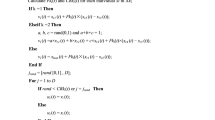Abstract
Evolutionary algorithms (EAs) are becoming increasingly popular tools for solving complex search problems. Their popularity in various problem domains has led to the introduction and development of numerous variants of two standard EA operators—crossover and mutation. Unfortunately, there are few if any effective guidelines for choosing which operators will be most effective in a given problem. In this paper, a self-tuning EA is introduced that employs several crossover and mutation operators simultaneously. The probability of using a given operator changes during the course of an evolutionary run whereby the most effective operators are selected based on which part of the search space is currently being explored. The self-tuning EA is used to solve an inverse partial differential equation—considered to be one of the more difficult problems in the realm of engineering mathematics. Results indicate that for the particular inverse partial differential equation considered, the self-tuning EA provides an effective solution methodology.
Similar content being viewed by others
References
L.D. Davis, The Handbook of Genetic Algorithms, Van Nostrand Reinhold: New York, 1991.
D.E. Goldberg, Genetic Algorithms in Search, Optimization, and Machine Learning, Addison-Wesley: Reading, MA, 1989.
T. Bäck, D.B Fogel, and Z. Michalewicz (eds.), Handbook of Evolutionary Computation, Oxford University Press: Oxford, 1997.
D. Whitley, D. Goldberg, E. Cantú-Paz, L. Spector, I. Parmee, and H.-G. Beyer, in Proceedings of the Genetic and Evolutionary Computation Conference, Morgan Kaufmann Publishers: San Francisco, CA, 2000.
C.L. Karr and L.M. Freeman (eds.), Industrial Applications of Genetic Algorithms, CRC Press: Boca Raton, FL, 1999.
R.J. Baur, Genetic Algorithms and Investment Strategies, John Wiley & Sons: New York, 1994.
H.M. Cartwright, “Genetic algorithms for the analysis of the movement of airborne pollution,” in Handbook of Evolutionary Computation, edited by T. Bäck, D.B. Fogel, and Z. Michalewicz, Van Nostrand Reinhold Company: New York, pp. G5.1.1–G5.1.8, 1997.
S.R. Michaud, J.B. Zydallis, G.B. Lamont, P.K. Harmer, and R. Pachter, “Protein structure prediction with EA immunological computation,” in Proceedings of the Genetic and Evolutionary Computation Conference, edited by L. Spector, E.D. Goodman, A. Wu, W.B. Langdon, H.-M. Voigt, M. Gen, S. Sen, M. Dorigo, S. Pezeshk, M.H. Garzon, and E. Burke, Morgan Kaufmann Publishers: San Francisco, CA, 2001.
V.S. Johnston and C. Caldwell, “Tracking a criminal suspect through face space with a genetic algorithm,” in Handbook of Evolutionary Computation, edited by T. Bäck, D.B. Fogel, and Z. Michalewicz, Van Nostrand Reinhold Company: New York, pp. G8.3.1–G8.3.8, 1997.
K. DeJong, Evolutionary Computation: A Unified Overview. 2001 Genetic and Evolutionary Computation Conference Tutorial Program, Morgan Kaufmann Publishers: San Francisco, CA, 2001, pp. 413–421.
G.R. Harik and F.G. Lobo, “Aparameter-less genetic algorithm,” in Proceedings of the Genetic and Evolutionary Computation Conference, edited by W. Banzhaf, J. Daida, A.E. Eiben, M.H. Garzon, V. Honavar, M. Jakiela, and R.E. Smith, vol. 1, Morgan Kaufmann Publishers: San Francisco, CA, 1999, pp. 258–265.
S. Rana, “The distributional biases of crossover operators,” in Proceedings of the Genetic and Evolutionary Computation Conference, edited by W. Banzhaf, J. Daida, A.E. Eiben, M.H. Garzon, V. Honavar, M. Jakiela, and R.E. Smith, vol. 1, Morgan Kaufmann Publishers: San Francisco, CA, 1999, pp. 549–556.
T.-P. Hong and H.-S. Wang, “Automatically adjusting crossover ratios of multiple crossover operators,” Journal of Information Science and Engineering, vol. 14, no.2, pp. 369–390, 1998.
Z. Michelowicz, Genetic Algorithms + Data Structures = Evolution Programs, Springer-Verlag: Berlin, 1992.
T. O'Neil, G. Farrell, H. Greenwald, D. Hartig, M.D. Lax, and P.V. O'Neil, Advanced Engineering Mathematics, Wadsworth Publishing Company: Belmont, CA, 1983.
D.L. Powers, Boundary Value Problems, 3rd edn., Harcourt Brace College Publishers: New York, 1987.
K.A. Hoffmann, Computational Fluid Dynamics for Engineers, Engineering Education System: Austin, TX, 1989.
W.H. Press, B.P. Flannery, S.A. Teukolsky, and W.T. Vetterling, Numerical Recipes in C: The Art of Scientific Computing, Cambridge University Press: Cambridge, 1998.
Author information
Authors and Affiliations
Rights and permissions
About this article
Cite this article
Karr, C.L., Wilson, E. A Self-Tuning Evolutionary Algorithm Applied to an Inverse Partial Differential Equation. Applied Intelligence 19, 147–155 (2003). https://doi.org/10.1023/A:1026097605403
Issue Date:
DOI: https://doi.org/10.1023/A:1026097605403




